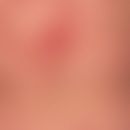Synonym(s)
HistoryThis section has been translated automatically.
Davis, 1966; Buckley, 1972
DefinitionThis section has been translated automatically.
Hyper-IgE syndrome consists of a small group of rare, genetically heterogeneous, mostly autosomal recessive inherited immunodeficiency syndromes (multisystem disease) with the following clinical triad:
- Recurrent skin infections mainly due to staphylococci (skin abscesses, with low inflammation/cold abscesses).
- Recurrent upper and lower respiratory tract infections (bronchitis, eosinophilic pulmonary infiltrates, bronchopneumonia-J18.0)
- excessive elevation of serum IgE and recurrent blood eosinophilia (D72.1).
In addition, depending on the genotype, there are a number of other clinical symptoms (skeletal abnormalities, including craniosynostosis and scoliosis, short stature, hip dislocation, craniosynostosis, bronchiectasis, finger contractures, elbow contractures, impacted teeth, high palate, atopic dermatitis; diarrhea, speech disorders).
You might also be interested in
Occurrence/EpidemiologyThis section has been translated automatically.
Rare; about 300 cases have been described in the literature to date.
EtiopathogenesisThis section has been translated automatically.
The phenotype "Hyper IgE syndrome" is characterized by a variable genoype.
Autosomal dominant genotype:
- Hyper-IgE syndrome 1/ AD, HIES1 (147060): STAT3 gene/ autosomal dominant variant, most common!
Other autosomal - recessive variants:
- Hyper-IgE syndrome 2/ AR, HIES2 ((243700): DOCK8 gene (DOCK8=Dedicator of cytokinesis 8-protein
- Hyper IgEsyndrome 3/ AR, HIES3 (618282): ZNF431 gene(ZNF431=Zinc finger 431 gene)
- Hyper-IgE syndrome 4/ AR, HIES4A/4B (618523): IL6ST gene (IL6ST=Interleukin 6 Cytokine Family Signal Transducer)
Hyper IgE syndrome 5/ AR, HIES5 (618944): IL6R gene (IL6R = Interleukin 6 receptor)
_________________________________________________________________________________________________
Hyper-IgE-like immunodeficiency syndromes with mutations in the genes (TYK2, PGM3, SPINK5,TGFBR1):
Immunodeficiency 35: TYK2 gene (tyrosine kinase defect/OMIM:611521).
Immunodeficiency 23: PGM3 gene (phosphoglucomutase3 defect/OMIM:615816)
Netherton syndrome: SPINK5 gene (Serine Peptidase Inhibitor Kazal 5/OMIM:256500)
Loeys-Dietz syndrome: TGFBR1 gene("Transforming Growth Factor Beta Receptor 1"/OMIM 609192). Patients with Loeys-Dietz syndrome, a complex connective tissue disorder, often develop immunological disorders: food allergies, asthma or signs of atopic dermatitis or inflammatory bowel disease. In this case, there are overlaps with the hyper-IgE syndrome.
ManifestationThis section has been translated automatically.
LocalizationThis section has been translated automatically.
Skin: Face, hairy head, neck region.
Mucous membranes: Upper and lower airways.
ClinicThis section has been translated automatically.
Mostly manifestation as "superinfected atopic eczema" or as"eosinophilic pustular folliculitis" (Chamlin SL et al. 2002) , with recurrent abscessing infections of the skin (face, neck region), mucous membranes of the upper (sinusitis, otitis media) and lower (in 40% of patients eosinophilic lung infiltrates are detectable/eosinophilicpneumonia) airways and lung cysts.
Recurrent bacterial infections with characteristic distribution pattern: skin (face, hairy head, neck region), mucous membranes of the upper airways (sinusitis, otitis media) and lungs (pneumonia). The pathogen is predominantly Staphylococcus aureus; however, other gram-positive and gram-negative pathogens are also frequently detected. Abscesses often form with or without clinical signs of inflammation (frequently "cold abscesses", but not obligatory).
Mycotic infections are common, usually progressing as mucocutaneous candidiasis, with severe nail dystrophies.
Dental changes: Persistent deciduous teeth due to non-attachment or delayed eruption, high arched palate.
Isolated cases with associated cutis verticis gyrata have been described. Juvcnile cases with associated bullous pemphigoid are known (Erbagci Z 2008).
LaboratoryThis section has been translated automatically.
DiagnosisThis section has been translated automatically.
IgE:polyclonal increase usually > 5000 IU/ml.
RAST:frequent staphylococcal and Candida-specific IgE.
Blood count:recurrent eosinophilia.
In infections, often absent or low increase in acute phase proteins.
Sputum and abscess smear: eosinophilia.
Lymphocyte transformation test:normal response to PHA and ConA and decreased response to antigens e.g. tetanus.
Differential diagnosisThis section has been translated automatically.
Atopic dermatitis; eosiophilia of other (e.g., reactive) etiology.
Complication(s)(associated diseasesThis section has been translated automatically.
External therapyThis section has been translated automatically.
Internal therapyThis section has been translated automatically.
No uniform therapy regimen; the results are often unsatisfactory, symptomatic therapy is the main focus. Therapy adapted to the recurrent infections. Often staphylococcal infections, therefore penicillinase-resistant penicillins such as dicloxacillin (e.g. InfectoStaph) or flucloxacillin (e.g. Staphylex Kps.) 2-3 g/day in 3 ED. Antihistamines like Desloratadine (e.g. Aerius) 1 tbl/day against severe itching. If necessary, anticoagulatory therapy to prevent thrombembolic events. Close-meshed controls for bacterial and mycotic superinfections! Risk of pulmonary insufficiency after recurrent pneumonia.
Glucocorticoids are mainly used for urticarial efflorescences and angioedema in medium dosage, e.g. Prednisolon 40-60 mg/day (e.g. Decortin H Tbl.), slow release, maintenance dose: 2-10 mg/day p.o. Vit. C and cimetidine (e.g. Tagamet Filmtbl. 2 times 200 g/day) should reduce the frequency of infection. The use of isotretinoin should reduce the frequency of staphylococcal infections.
Interferons such as interferon gamma. 0.05 mg/m2 KO have been tried in individual cases. In severe cases, high-dose glucocorticoids in combination with cytostatic drugs such as hydroxycarbamide (e.g. Litalir) 50-80 mg/kg bw/day p.o. are used. Vincristine (especially in cases of a massive increase in eosinophils), etoposide or chlorambucil are also suitable combination partners.
Gamma globulins or plasmapheresis can be tried.
Progression/forecastThis section has been translated automatically.
LiteratureThis section has been translated automatically.
- Al-Shaikhly T et al (2019) Hyper IgE syndromes: clinical and molecular characteristics. Immunol Cell Biol 97:368-379.
- Belohradsky BH, Däumling S, Kiess W, Griscelli C (1987) The hyper IgE syndrome (Buckley or Job syndrome). Results of Internal Medicine and Pediatrics 55: 1-39.
- Buckley RM, Wray BB, Belmaker EZ (1972) Extreme hypergammaimmunoglobulinemia E and undue susceptibility to infection. Pediatrics 49: 59
- Buckley RH, Becker WG (1978) Abnormalities in the regulation of human IgE synthesis. Immune Rev 41: 288-314
- Chamlin SL et al (2002) Cutaneous manifestations of hyper-IgE syndrome in infants and children. J Pediatr 141: 572-575.
- Davis SD, Schaller J, Wedgwood RJ (1966) Job's syndrome: recurrent, 'cold,' staphylococcal abscesses. Lancet I: 1013-101
- Erbagci Z (2008) Childhood bullous pemphigoid in association with hyperimmunoglobulin E syndrome. Pediatr Dermatol 25: 28-33.
- Frey-Jakobs S et al (2018) ZNF341 Controls STAT3 Expression and Thereby Immunocompetence. Sci Immunol 3(24):1-11.
- Grimbacher B et al (1999) Hyper-IgE syndrome with recurrent infections--an autosomal dominant multisystem disorder. N Engl J Med 340: 692-702.
- Hochreutener H et al (1991) Variant of Hyper-Ig-E syndrome: The differentiation from atopic dermatitis is important because of treatment and prognosis. Dermatologica 182: 7-11
- Ito R et al (2003) Selective insufficiency of IFN-gamma secretion in patients with hyper-IgE syndrome. Allergy 58: 329-336
Incoming links (36)
antimicrobial peptides ; Bronchiectasis; Buckley syndrome; Chronic mucocutaneous candidiasis; Dental diseases, skin changes; Dock8 deficiency; DOCK8 Gene; Eosinophilia and skin; ERBIN gene; Hesa; ... Show allOutgoing links (55)
Acute-phase proteins; Antihistamines, systemic; Atopic dermatitis (overview); Bronchiectasis; Chronic mucocutaneous candidiasis; Clioquinol; Clioquinol cream 0.5-2% (o/w); Cutaneous non hodgkin lymphomas; Cutis verticis gyrata; Cytostatics (overview); ... Show allDisclaimer
Please ask your physician for a reliable diagnosis. This website is only meant as a reference.





